fuel BUICK PARK AVENUE 1994 Owners Manual
[x] Cancel search | Manufacturer: BUICK, Model Year: 1994, Model line: PARK AVENUE, Model: BUICK PARK AVENUE 1994Pages: 324, PDF Size: 17.01 MB
Page 14 of 324
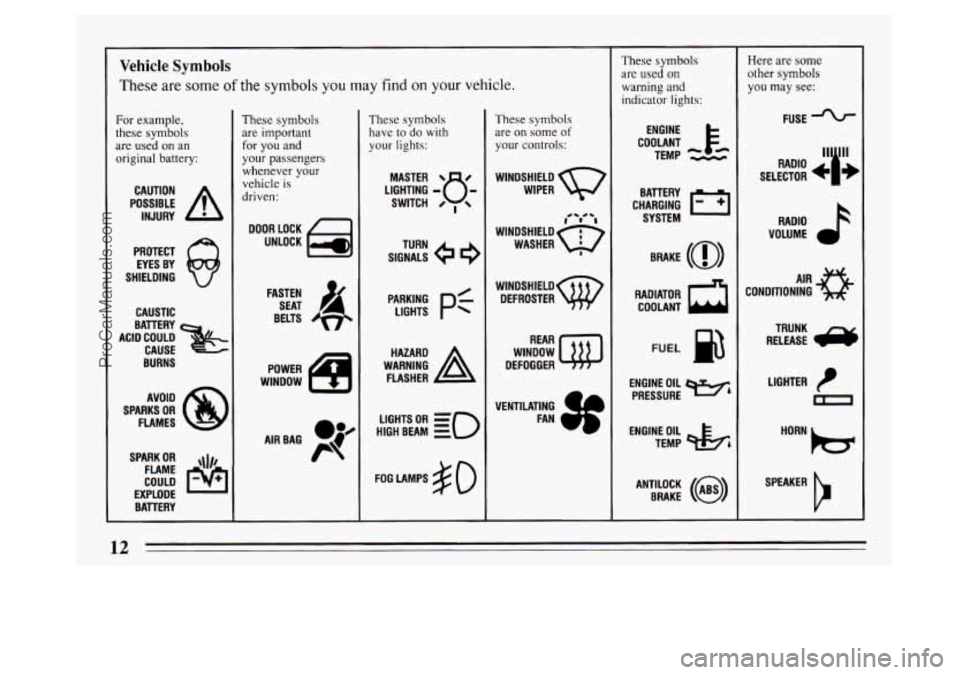
Vehicle Symbols
These are some of the symbols you may find on your vehicle.
For example,
these symbols are used on an
original battery:
POSSIBLE A
CAUTION
INJURY
PROTECT EYES BY
SHIELDING
CAUSTIC
BURNS AVOID
SPARKS
OR
FLAMES
SPARK
OR ,111,
COULD FLAME
EXPLODE BATTERY
These symbols are important
for you and
your passengers
whenever your
vehicle
is
driven:
DOOR LOCK
UNLOCK
FASTEN SEAT
4
BELTS
POWER
WINDOW
These symbols
have to
do with
your lights:
WARNING A
HAZARD
FLASHER
HIGH BEAM OR
= -0
FOG LAMPS $0
These symbols
are on some
of
your controls:
WINoSHIELD WIPER w
WINDSHIELD
DEFROSTER
WINDOW
DEFOGGER
VENTILATING FAN
These symbols
are
used on
warning and indicator lights:
CHARGING 1-1
BATTERY
SYSTEM
RADIATOR
a
COOLANT
FUEL
ENGINE OIL
PRESSURE
Wb
TEMP OIL &
ANTILOCK (a)
BRAKE
Here are some
other symbols you may see:
FUSE
RADIO
"i"
SELECTOR fi
RADIO >
VOLUME
LIGHTER
n
12
ProCarManuals.com
Page 80 of 324
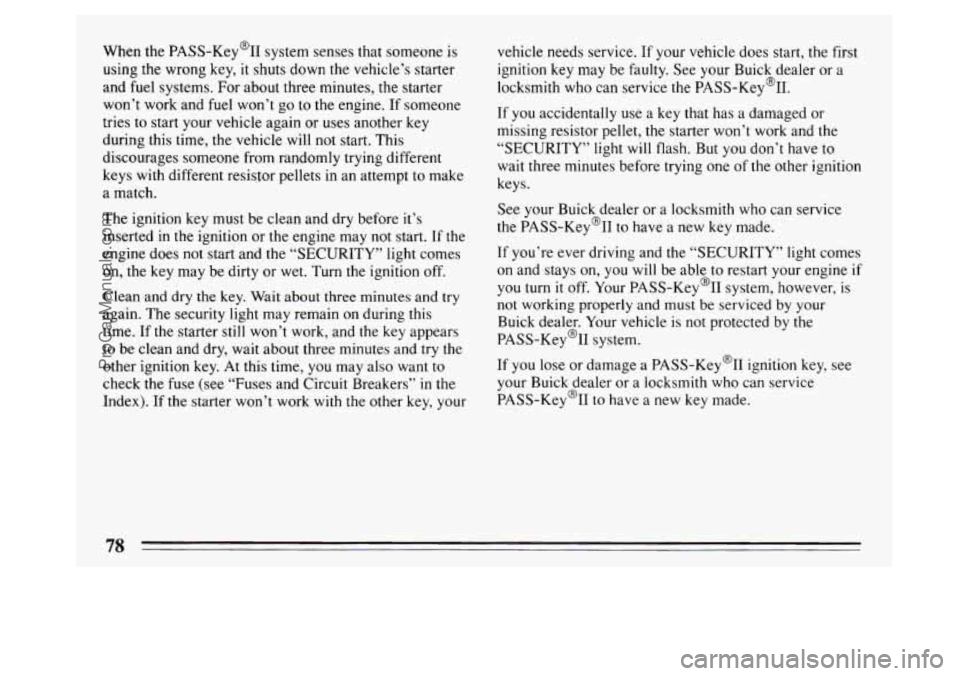
When the PASS-Key% system senses that someone is using the wrong key,
it shuts down the vehicle’s starter
and fuel systems. For about three minutes,
the starter
won’t work and
fuel won’t go to the engine. If someone
tries to start your vehicle again or uses another key
during this time, the vehicle will not start. This
discourages someone from randomly trying different
keys with different resistor pellets in an attempt to make
a match.
The ignition key must be clean and dry before it’s
inserted in the ignition or the engine may not start. If the
engine does not start and the “SECURITY’’ light comes
on, the key may be dirty
or wet. Turn the ignition off.
Clean and dry the key. Wait about three minutes and try
again. The security light may remain on during this
time. If
the starter still won’t work, and the key appears
to be clean and dry, wait about three minutes and try the
other ignition key. At this time, you may also want to
check the fuse (see “Fuses and Circuit Breakers”
in the
Index). If
the starter won’t work with the other key, your vehicle needs
service. If your vehicle does start, the first
ignition key may be faulty. See your Buick dealer or a
locksmith who can service the PASS-Key@II.
If you accidentally use a key that has a damaged or
missing resistor pellet, the starter won’t work and the
“SECURITY” light
will flash. But you don’t have to
wait three minutes before trying one of the other ignition
keys.
See your Buick dealer or
a locksmith who can service
the PASS-Key@II to have a new key made.
If you’re ever driving and the “SECURITY” light comes
on and stays on,
you will be able to restart your engine if
you turn it off. Your PASS-Key% system, however, is
not working properly
and must be serviced by your
Buick dealer. Your vehicle is not protected by the
PASS-Key% system.
If you lose or damage a PASS-Key@II ignition key, see
your Buick dealer or a locksmith who can service
PASS-Key@II to have a
new key made.
78
ProCarManuals.com
Page 84 of 324
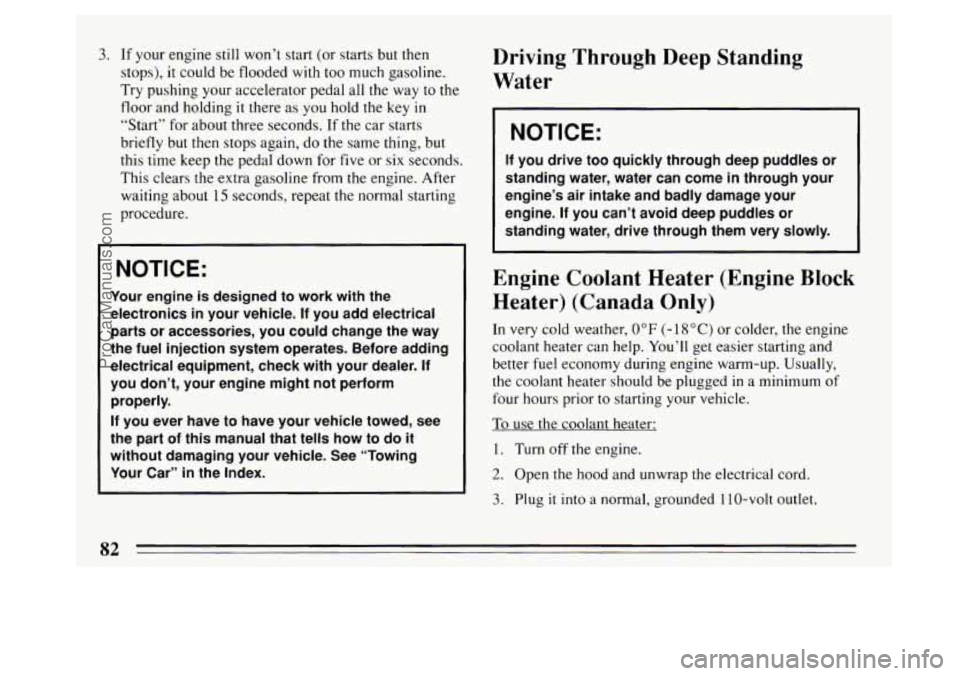
3. If your engine still won’t start (or starts but then
stops),
it could be flooded with too much gasoline.
Try pushing your accelerator pedal all the way to the
floor and holding
it there as you hold the key in
“Start” for about three seconds. If the car starts
briefly but then stops again, do the same thing, but
this time keep the pedal down for five or
six seconds.
This clears the extra gasoline from the engine. After
waiting about
15 seconds, repeat the normal starting
procedure.
NOTICE:
Your engine is designed to work with the
electronics in your vehicle.
If you add electrical
parts or accessories, you could change the way
the fuel injection system operates. Before adding
electrical equipment, check with your dealer.
If
you don’t, your engine might not perform
properly.
If you ever have to have your vehicle towed, see
the part of this manual that tells how to
do it
without damaging your vehicle. See “Towing
Your Car”
in the Index.
Driving Through Deep Standing
Water
I NOTICE:
If you drive too quickly through deep puddles or
standing water, water can come
in through your
engine’s air intake and badly damage your
engine.
If you can’t avoid deep puddles or
standing water, drive through them very slowly.
Engine Coolant Heater (Engine Block
Heater) (Canada Only)
In very cold weather, 0°F (- 18 “C) or colder, the engine
coolant heater can help. You’ll get easier starting and
better fuel economy during engine warm-up. Usually,
the coolant heater should be plugged
in a minimum of
four hours prior to starting your vehicle.
To use the coolant heater:
1. Turn off the engine.
2. Open the hood and unwrap the electrical cord.
3. Plug it into a normal, grounded 1 10-volt outlet.
82
ProCarManuals.com
Page 87 of 324
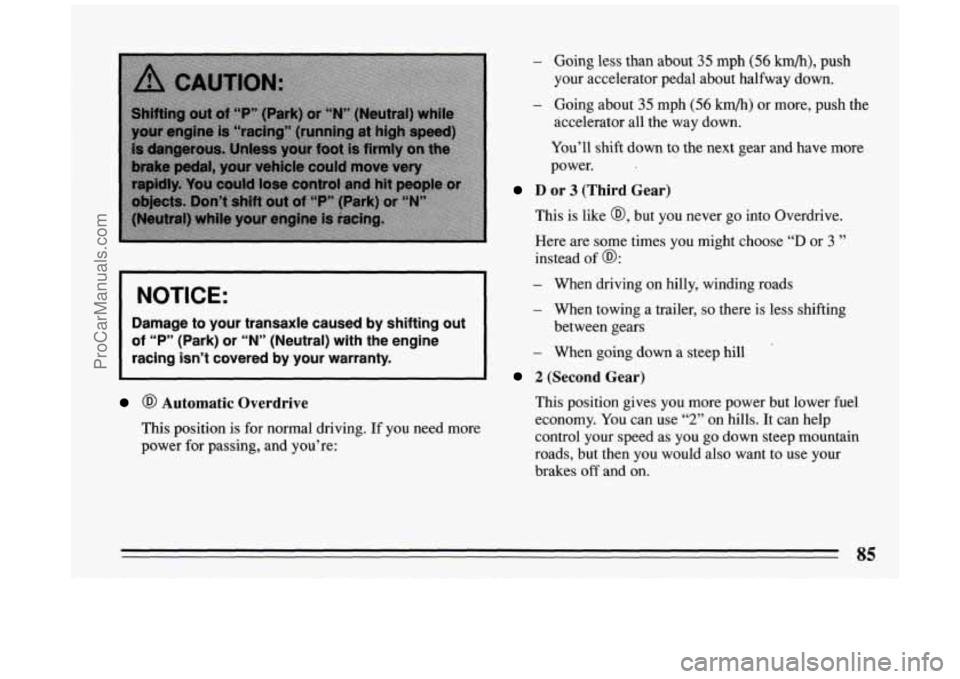
NOTICE:
Damage to your transaxle caused by shifting out
of “P” (Park) or “N” (Neutral) with the engine
racing isn’t covered by your warranty.
@ Automatic Overdrive
This position is for normal driving. If you need more
power for passing, and you’re:
- Going less than about 35 mph (56 km/h), push
your accelerator pedal about halfway down.
- Going about 35 mph (56 km/h) or more, push the
accelerator all the way down.
You’ll shift down to the next gear and have more
power.
D or 3 (Third Gear)
This is like @, but you never go into Overdrive.
Here are some times you might choose
“D or 3 ”
instead of @:
- When driving on hilly, winding roads
- When towing a trailer, so there is less shifting
- When going down a steep hill
between
gears
2 (Second Gear)
This position gives you more power but lower fuel
economy.
You can use “2” on hills. It can help
control your speed as you go down steep mountain
roads,
but then you would also want to use your
brakes
off and on.
QL
ProCarManuals.com
Page 88 of 324
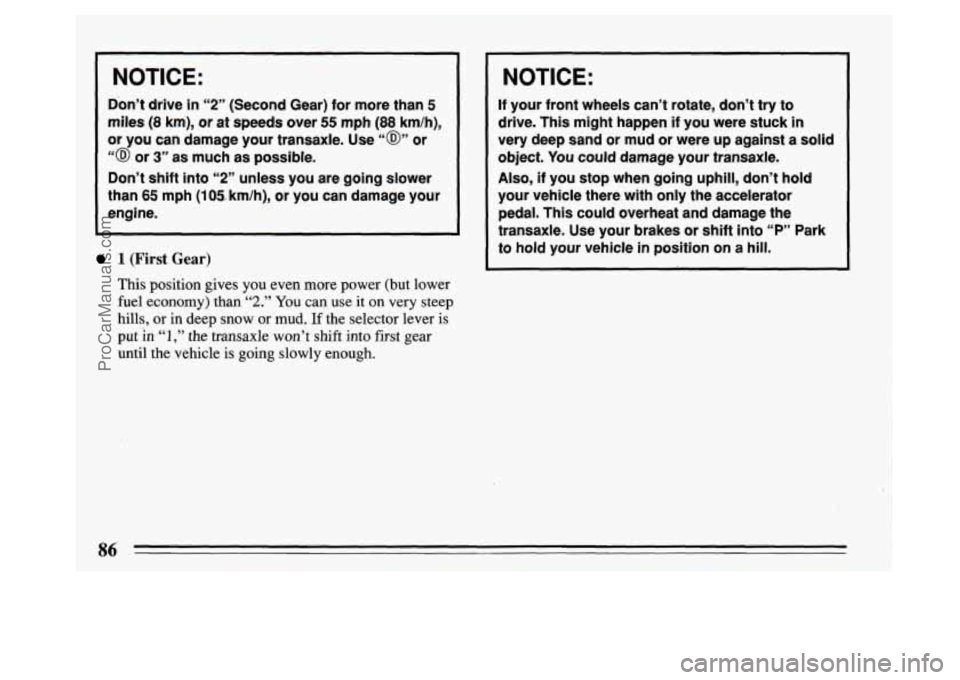
NOTICE:
Don’t drive in “2” (Second Gear) for more than 5
miles (8 km), or at speeds over 55 mph (88 km/h),
or you can damage your transaxle. Use
“@” or
“@ or 3” as much as possible.
Don’t shift into
“2” unless you are going slower
than
65 mph (105 km/h), or you can damage your
engine.
1 (First Gear)
This position gives you even more power (but lower
fuel economy) than
“2.” You can use it on very steep
hills, or in deep snow or mud. If the selector lever is
put in
“1,” the transaxle won’t shift into first gear
until the vehicle is going slowly enough.
NOTICE:
If your front wheels can’t rotate, don’t try to
drive. This might happen if you were stuck in
very deep sand
or mud or were up against a solid
object. You could damage your transaxle.
Also, if you stop when going uphill, don’t hold
your vehicle there
with only the accelerator
pedal. This could overheat and damage the
transaxle. Use your brakes or shift into
“P” Park
to hold your vehicle in position on a hill.
ProCarManuals.com
Page 121 of 324

The Instrument Panel: Your
Information System
I
Speedometer and Odometer
Your speedometer lets you see your speed in both miles
per hour (mph) and kilometers per hour (km/h). Your
odometer shows how far your vehicle has been driven,
in either miles (used in the U.S.) or kilometers (used in
Canada).
Your Buick has
a “tamper-resistant odometer.’’ If you
can see very noticeable bright silver lines between the
numbers, probably someone has tried
to turn it back.
The numbers may not be true.
You may wonder what happens if a car has to have a
new odometer installed.
If possible, the new one has to
be set to the same reading the old one had.
If it can’t be,
then it’s set at zero, and a label on the driver’s door must
show the old reading and when the new one was
installed.
Your instrument panel is designed to let you know at a
glance how your car
is running. You’ll know how fast
you’re going, how much fuel you’re using, and many
other things you’ll need
to know to drive safely and
economically.
119
ProCarManuals.com
Page 123 of 324
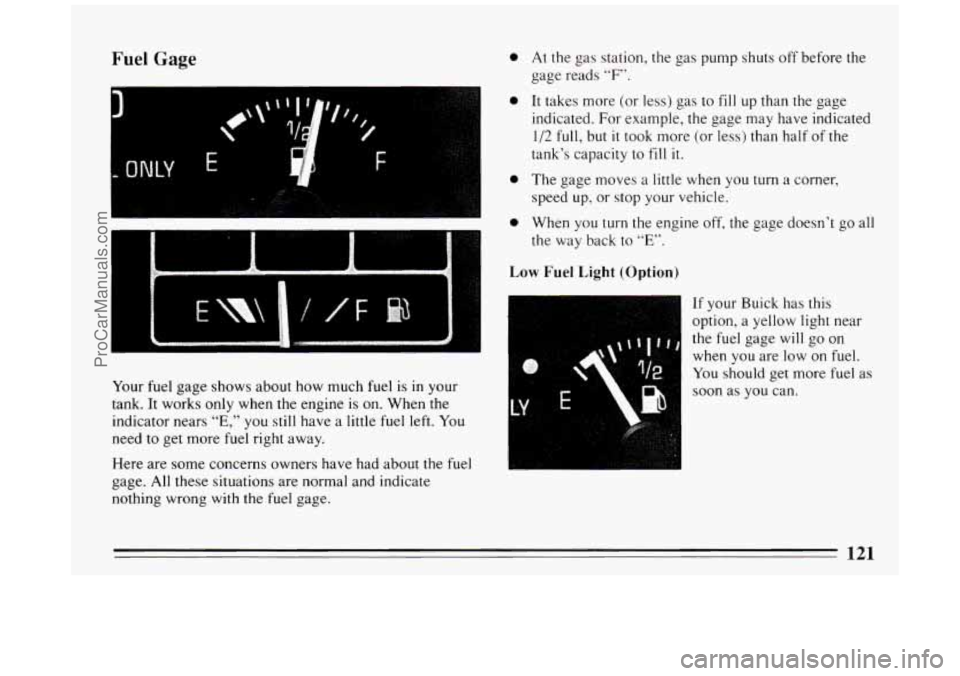
Fuel Gage
Your fuel gage shows about how much fuel is in your
tank. It works only when the engine is on. When the
indicator nears
“E,” you still have a little fuel left. You
need to get more fuel right away.
Here are some concerns owners have had about
the fuel
gage. All these situations are normal and indicate
nothing wrong with the fuel gage.
0
0
0
0
At the gas station, the gas pump shuts off before the
gage reads
“F’.
It takes more (or less) gas to fill up than the gage
indicated.
For example, the gage may have indicated
1/2 full, but it took more (or less) than half of the
tank’s capacity to
fill it.
The gage moves a little when you turn a corner,
speed up, or stop your vehicle.
When you turn the engine off, the gage doesn’t go all
the way back to
“E”.
Low Fuel Light (Option)
If your Buick has this
option, a yellow light near
the fuel gage will
go on
when
you are low on fuel.
You should get more fuel as
soon as
you can.
121
ProCarManuals.com
Page 130 of 324

Malfunction Indicator Lamp (Service
Engine Soon Light)
SERVICE
ENGINE SOON
NOTICE:
If you keep driving your vehicle with this light on,
after a while the emission controls won’t work as
well, your fuel economy won’t be as good and your engine may not run
as smoothly. This could
lead to costly repairs not covered by your
warranty.
SERVICE
ENGINE
SOON
Battery Light
A computer monitors operation of your fuel, ignition
and emission control systems. This light should come on
when the ignition is on and the engine is not running, as
a check to show you it is working.
If it does not come on
at all, have it fixed right away. If it stays
on, or it comes
on while you are driving, the computer
is indicating that
you have
a problem. You should take your vehicle in for
service soon.
n
VOLTS
When you turn the key to RUN, this light will come on
briefly,
to show that your alternator and battery charging
systems are working. If the light stays on, you need
ProCarManuals.com
Page 139 of 324
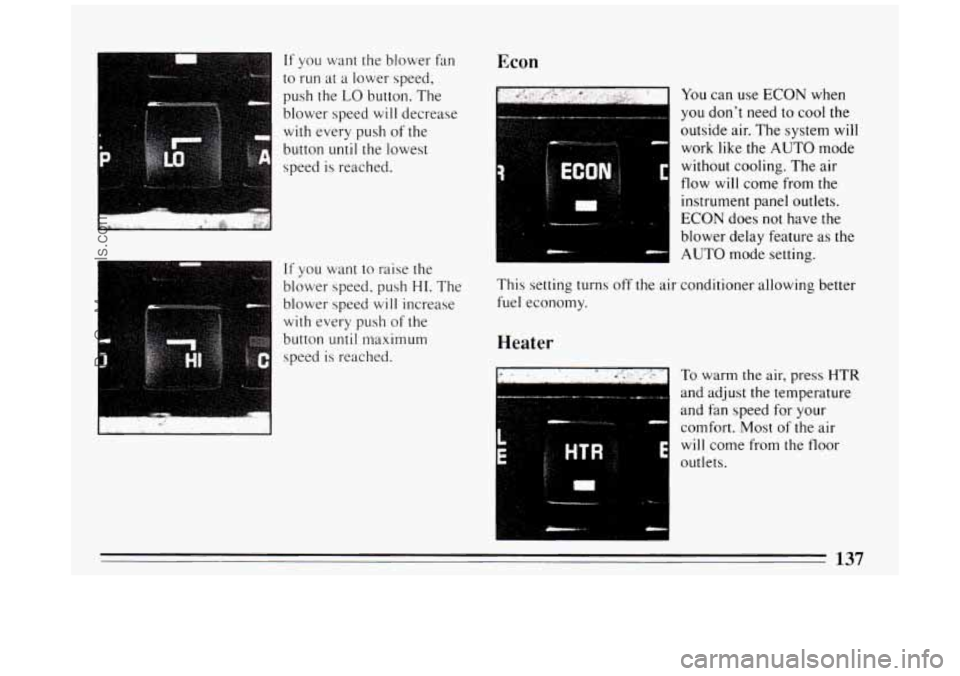
If you want the blower fan
to run at a lower speed,
push the
LO button. The
blower speed
will decrease
with every push of the
button
until the lowest
speed is reached.
If you want to raise the
blower speed, push
HI. The
blower speed
will increase
with every
push of the
button
until maximum
speed
is reached.
Econ
You can use ECON when
you don’t need to cool the
outside air. The system will
work like the AUTO mode
without cooling. The air
flow
will come from the
instrument panel outlets.
ECON does not have the
blower delay feature as
the
AUTO mode setting.
This setting turns off the air conditioner allowing better
fuel economy.
Heater
To warm the air, press mR
and adjust the temperature
and fan speed for your
comfort. Most of the air
will come from the floor
outlets.
137
ProCarManuals.com
Page 142 of 324
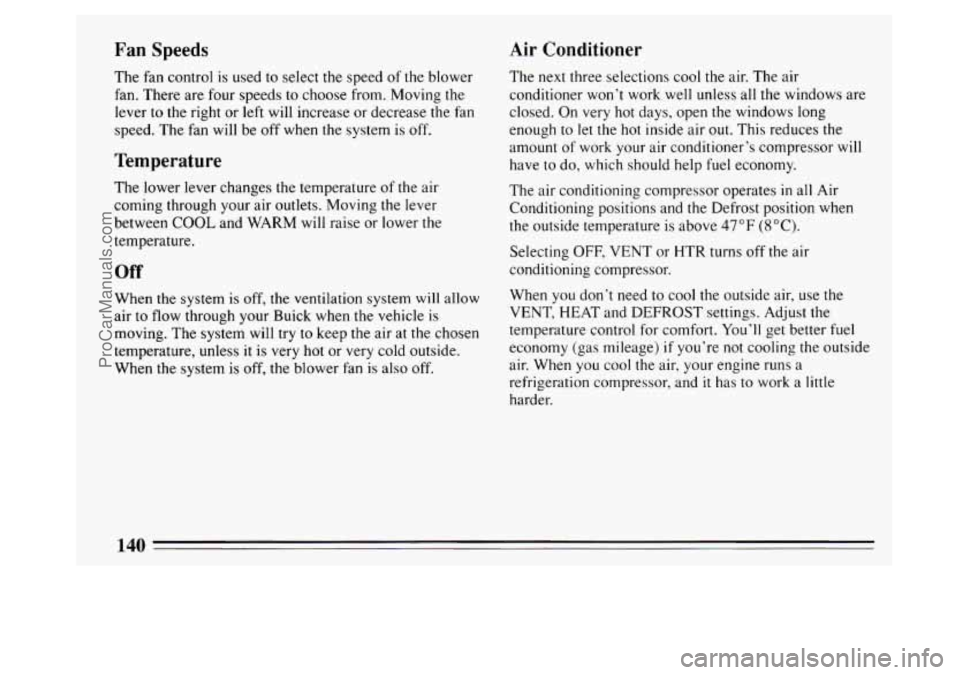
Fan Speeds Air Conditioner
The fan control is used
to select the speed of the blower
fan. There are four speeds to choose from. Moving the
lever to the right or
left will increase or decrease the fan
speed. The fan will be off when the system is
off.
Temperature
The lower lever changes the temperature of the air
coming through your air outlets. Moving the lever
between
COOL and WARM will raise or lower the
temperature.
Off
When the system is off, the ventilation system will allow
air to
flow through your Buick when the vehicle is
moving. The system will try to keep the air at the chosen
temperature, unless
it is very hot or very cold outside.
When the system is off, the blower fan is also off. The
next three selections cool the air. The air
conditioner won’t work well unless all the windows are
closed. On very hot days, open the windows long
enough to let the hot inside air out. This reduces the
amount of work your air conditioner’s compressor
will
have to do, which should help fuel economy.
The air conditioning compressor operates
in all Air
Conditioning positions and
the Defrost position when
the outside temperature
is above 47°F (SOC).
Selecting OFF, VENT or HTR turns off the air
conditioning compressor.
When you don’t need to cool the outside air, use the
VENT, HEAT and DEFROST settings. Adjust the
temperature control for comfort. You’ll get better fuel
economy (gas mileage)
if you’re not cooling the outside
air. When you cool the air, your engine runs a
refrigeration compressor, and
it has to work a little
harder.
140
ProCarManuals.com